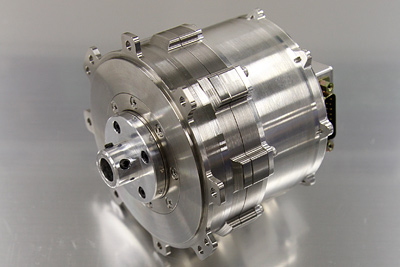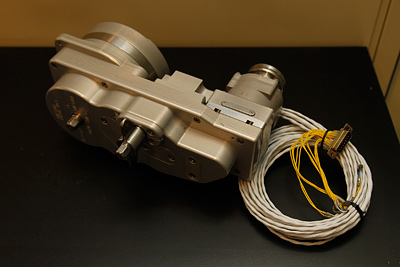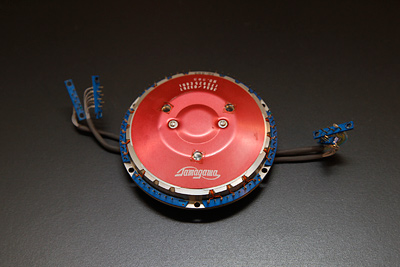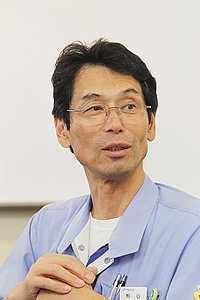Motor & Sensor Production in a Pleasant Factory
Tamagawa Seiki, founded in 1938, has long run a thriving business as a maker of precision parts. The company got its start by manufacturing oil gauges for fighter planes, but now it develops and produces a wide range of precision parts including angle sensors, gyros, servomotors and step motors which are sold to makers of robots, machine tools, aircraft, military hardware and more. Since recently, Tamagawa Seiki’s resolvers (rotation angle detection sensors) have been used in power steering motors for hybrid vehicles (HVs) and electric vehicles (EVs).
Tamagawa Seiki entered the space business in the mid-1980s, starting with gyros used for the H-I rocket’s inertial navigation, followed by the development and manufacture of motors, encoders, resolvers and other equipment used in a variety of satellites and probes. The company’s products are also used in Kibo, the Japanese Experiment Module (JEM) on the International Space Station (ISS), and Konotori, the space station supply ship.
Tamagawa Seiki manufactures its aeronautics-related products at the First Plant in Iida, Nagano Prefecture, adjacent to the company’s headquarters. The facility was constructed in 1942, when it was called the Iida Plant, and the original buildings still look the same, giving the site a unique charm. The Spacetronics Laboratory, which conducts research and development on astronautics products, is also located on the property.
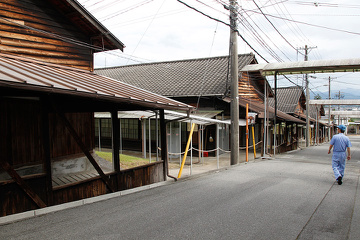
Tamagawa Seiki’s First Plant in Iida, Nagano Prefecture. Some of the buildings still retain the same appearance they had when constructed in 1942.
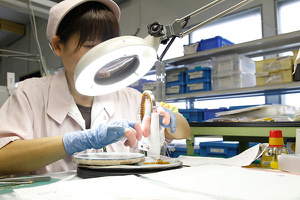
Since components for use in space are not mass produced, much of the production is done by hand. Precise work is essential for many of the processes involved. In the photo above, an employee is winding wires for motors and sensors.
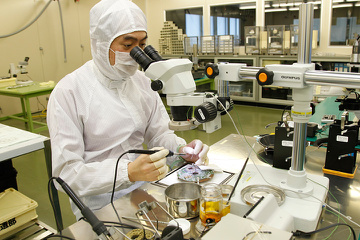
Angle detector boards are assembled in a Class 1000 cleanroom. Precise records must be kept for every product manufactured and inspected in order to ensure reliability.


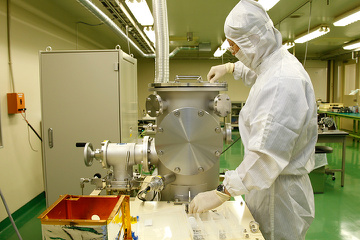
Tamagawa Seiki installed a space chamber to test and check products for use in space. Inside the chamber is a vacuum that simulates an outer space environment with a temperature range of -60 to +90 ℃ in order to check product durability.
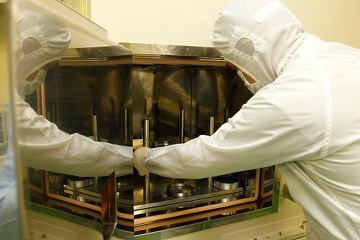
The company installed a thermostatic chamber for testing and checking. This equipment can maintain a constant temperature with a variation of only +/-2℃ within a range of -70 to +120 ℃ in order to check product durability.

Most astronautics equipment is plated with gold to ensure conductivity and enhance durability. The photo above shows gold plating equipment installed in a cleanroom.
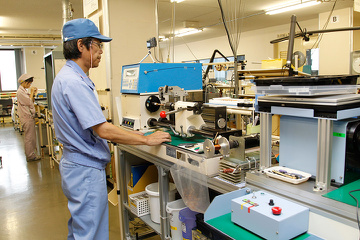
This line assembles motors. The photo shows a coil winding machine.


A motor assembly line also requires rigorous inspections. The photo shows an inspection operation for a linear motor.
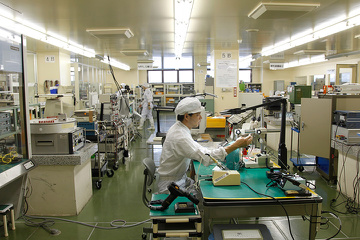
This is a gyro assembly line. Gyros are produced in a Class 100000 cleanroom.
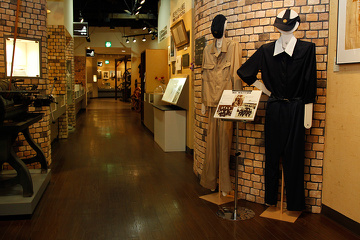
A history museum with displays of products resulting from Tamagawa Seiki’s R&D sits inside the First Plant.
TAMAGAWA SEIKI CO., LTD.
| HQ Location | Iida, Nagano Prefecture |
|---|---|
| Established | 1938 |
| Main Facilities | First Plant (Iida, Nagano Prefecture) Second Plant (Iida, Nagano Prefecture) Third Plant (Matsukawa, Nagano Prefecture) Hachinohe Plant (Hachinohe, Aomori Prefecture) |
| Main Products | Encoders, resolvers, gyros, servomotors, step motors, inertial sensors, servomechanisms, etc. |
| Main Astronautics Equipment Produced | Step motor for Akebono, the Aurora Observation Satellite (1989) Brushless DC motor, step motor and resolver for Midori, the Advanced Earth Observation Satellite (1996) Gear mechanism with brakes and resolver for Orihime and Hikoboshi, the Engineering Test Satellites (1997) Optical encoder for Kiku 6, the Engineering Test Satellite (1994)Step motor for Kaguya, the Selenological and Engineering Explorer (2007) Actuator, brushless DC motor and brushless resolver for Kibo, the Japanese Experiment Module on the Int'l Space Station (2008) Actuator, step motor and resolver for Ibuki, the Greenhouse Gases Observing Satellite (2009) Exposed pallet shaft, wheels and more for Konotori, the ISS supply ship (2011) |
| Corporate site | http://www.tamagawa-seiki.com/english/ |
INTERVIEW
インタビュー
Enhancing Product Lineups
and Supplying Diverse Equipment
TAMAGAWA SEIKI CO., LTD.
Managing Director and First Plant Manager
Hideo Kumagai
Enhancing Product Lineups and Supplying Diverse Equipment
First, please tell us what kind of astronautics equipment you are developing and manufacturing.
Mostly motors. For example, motors that are installed on Kibo, the Japanese Experiment Module (JEM) on the International Space Station (ISS). After that there's sensors that detect angles. These are called resolvers, which, based on the same principle as a motor, detect angles electromagnetically. We're also working on revolving parts in general, like gimbals and reaction wheels.
One unique product Tamagawa Seiki is developing is a slip ring for space. This is placed in the wiring between a radar that rotates mechanically around a solar array or antenna, and the main body, which does not rotate. This component is called "free-spinning wiring." It's to keep the circuitry from getting twisted up. Our company is developing it as part of a project promoted by the Japan Aerospace Exploration Agency (JAXA) to assemble standard parts for space.
Tamagawa Seiki was established before World War II, right?
Yes, it was founded in 1938 in Kamata, Tokyo, near the mouth of the Tama River, hence the name of the company. (The Japanese for "Tama River" is "Tamagawa.") Our first product was a fuel gauge for fighter plane fuel tanks. It used a wooden float on top of the fuel. The float was connected to the wall of the tank with a wood bracket. A resolver detected the angle between the wall and bracket so that the pilot could see on the cockpit instrument board how much fuel was left. When war broke out, the company evacuated to Iida, Nagano Prefecture, the company founder's hometown. That became the current site of the First Plant.
After the war, demand in the private sector gradually rose for the engineering we built up from mainly developing and manufacturing products for military use. Today, 80% of our sales are to the automotive industry and other civilian operations. The rest are products for defense and aerospace.
A recent hit product has been a resolver installed in motors for hybrid vehicles (HVs) and electric vehicles (EVs). We now hold the largest share in the market worldwide.
When did you first start making astronautics equipment?
We've been doing that since the mid-1980s. At that time, the National Space Development Agency of Japan (NASDA) started having mechanical guidance control gyros for the H-I rocket - the first of which launched in 1986 - produced domestically. So Tamagawa Seiki started making astronautics equipment when we built angle sensors for these gyros.
After that we made the step motor that drives the monitoring device's mirror in Akebono, the Aurora Observation Satellite, which was launched in 1989. More work started to come in a little at a time from then on, just like when we started making products for the private sector.
This work came to us when private companies saw the engineering we had deliberately built up producing military equipment and they asked us, "Can you make that for us, too?" Then we gradually started doing business in astronautics equipment.
By the way, how much are your sales of astronautics equipment?
Well as you know, a lot of them are unique parts, so the total sales are still not that big. The price of each part is high, but for civilian goods even though we make hundreds of thousands of each product, we only have to make a few prototypes before finalizing the design. So currently sales of astronautics equipment are just over 1% of the total.
However, they are slowly but surely increasing. We have high hopes for this business. Since we don't have any one part that sells in large quantities, we have to enhance our product lineup and supply a wide variety of equipment in order to increase sales.
We already have different series of motors for outer space in different sizes ranging from large to small. We intend to stay involved in this business and try to offer new equipment.
Where do your hopes rest in the space business?
This is a business where you can create sales by paying close attention to the engineering. Right now, the value of the yen continues to remain at record highs, but still we are keeping production in Japan and, besides that, this is a market where I think our company can survive.
Furthermore, astronautics equipment needs to be very reliable because it has to be in an environment with radiation and a vacuum, which doesn't exist on the Earth. Methods of ensuring this reliability are much different from those for the military hardware with which we're so familiar, but we have a lot of knowhow on how to make it reliable. One of the benefits from working on astronautics equipment is that you get to learn how to improve reliability.
For example, we keep meticulous records of the production history of each and every one of the parts we make for use in space. This is something that I think would very much perplex most typical manufacturers. I think that since traceability has become very serious lately with civilian goods as well, our experience with astronautics equipment will also help us with manufacturing these.
Another advantage has to do with recruiting. Students react very positively when they hear that a company works on astronautics equipment. So it's a huge advantage that helps us get top talent.
In addition, when we go out and sell civilian products and explain, "Our company also works on astronautics equipment," people trust our engineering and become more open to talking with us.
Meanwhile, what are some issues you need to deal with regarding astronautics equipment?
Improving profitability. There certainly are advantages to working with astronautics equipment, but we look at this from a business perspective, so it's important for us to make sure that we earn enough profit.
Lastly, please tell us what your hopes and aspirations are for your business with JAXA.
I have high hopes for the slip ring we're developing now, based on JAXA's approved parts system. We're planning to enhance our product lineup with this one, too.
The first JAXA-approved part was our angle sensor, followed by another company's reducer. We have a few other approved parts, but right now, like I said, I have high hopes for our slip ring. JAXA offers support for us to develop approved parts, but I'd be grateful if they'd have us make more like these.
Tamagawa Seiki employees who work in the company's astronautics business.
From right: Hiroshi Kushihara (Spacetronics Laboratory Chief),
Takashi Kumagai (First Plant Official Demand Production Department Manager),
Hideo Kumagai (Managing Director and First Plant Manager),
Hiroshi Arai (Spacetronics Laboratory Power Component Section and Development Management Section Head Instructor),
Kenji Shirota (Manager, General Affairs Section, General Affairs Department).
